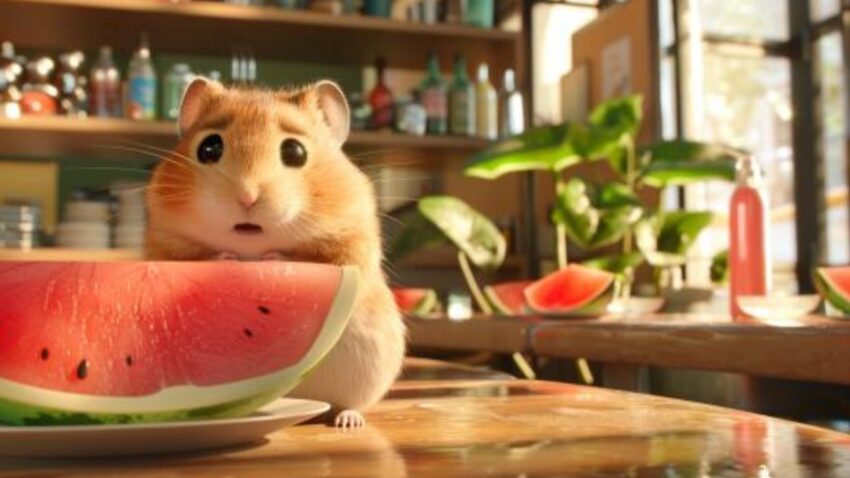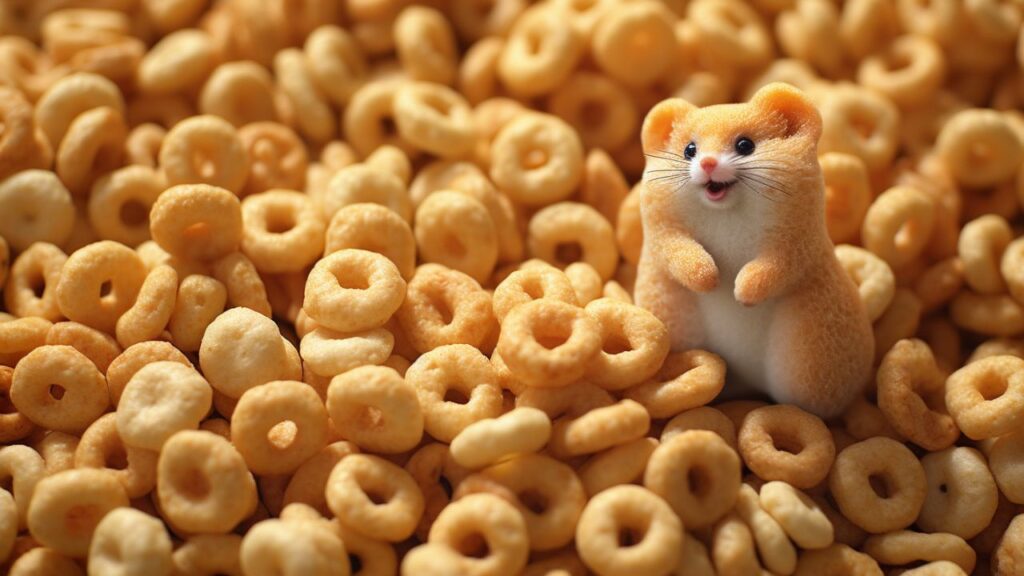TL;DR Summary
Hamsters can technically eat watermelon rind, but it’s not straightforward. If you choose to give your hamster watermelon rind, it must be organic, thoroughly washed, and the hard green outer layer removed. Serve only the white part in tiny, hamster-bite-sized pieces and in extreme moderation—no more than once a week and in very small quantities. Always monitor your hamster for any signs of digestive distress. Due to the potential risks, including the hard texture and possibility of chemical residues, it might be safer to stick with more conventional and hamster-friendly treats. Remember, the health and safety of your furry friend should always come first. And as always, a happy hamster is a wheel-y happy you!
When it comes to the diet of our beloved hamster companions, the line between nutritious snacking and potential harm can often be as fine as a strand of hamster fur. Pet owners, ever curious about the variety they can offer to their pet’s palate, frequently question the safety of various foods. The keyword stirring the pot of pet diet discussion today is [can hamsters eat watermelon rind]. This topic is not only ripe with curiosity but also with the potential to expand the menu of treats available to our tiny friends—if deemed safe.
Hamster Dietary Needs: A Quick Overview
Before introducing any new food into your hamster’s diet, it’s crucial to understand their basic dietary requirements. Hamsters are omnivores, which means they enjoy a varied diet of seeds, grains, fruits, vegetables, and occasionally, protein from animal sources. This complex diet is essential to their health, mimicking the diversity they would experience in the wild.
The Quest for Hamster-Safe Treats
Amidst the staples of their diet, treats play an important role in providing dietary diversity and enrichment. However, not all human foods are safe for hamster consumption. This makes the exploration into the world of potential snacks, such as watermelon rind, an important one for responsible hamster owners.
Investigating Watermelon Rind: The Hamster Perspective
The watermelon rind, the green outer skin that protects the juicy red fruit we all enjoy, is often discarded in the human kitchen. Yet, its destiny as a potential hamster snack hinges on a careful evaluation of its nutritional content and any risks it may pose to hamster health.
To Chew or Not to Chew?
It’s no secret that hamsters love to chew, and providing a variety of textures can help keep their ever-growing teeth in check. The question of whether the watermelon rind is an appropriate addition to their chewing repertoire is one that requires a closer look at its texture, hardness, and digestibility from a hamster’s perspective.
Nutritional Profile of Watermelon Rind
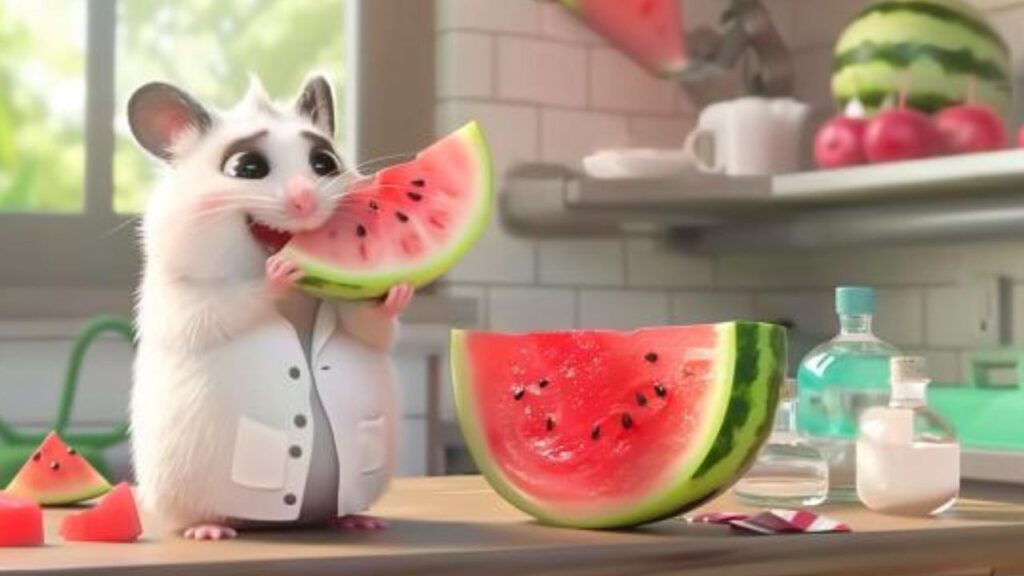
When considering the addition of new elements to a hamster’s diet, it’s imperative to carefully examine the food’s nutritional profile. This holds especially true for unconventional choices like watermelon rind, which is not commonly recognized as a traditional pet food. Let’s delve into the nature of watermelon rind and assess its nutritional content to determine its potential benefits for our hamster’s health.
What is Watermelon Rind?
Watermelon rind is the green outer skin and the white part of the watermelon, which encases the sweet, juicy, red fruit we commonly consume. While it’s often discarded as inedible or undesirable in human cuisine, the rind actually consists of a harder, more fibrous texture than the flesh, and it contains a variety of nutrients.
The Rind’s Role in Nature
In nature, the rind serves as a protective layer for the watermelon, keeping the moisture in and pests out. It’s robust and resilient, which raises the question of its suitability for the delicate digestive system of a hamster.
Nutritional Content and Benefits
The watermelon rind is not devoid of nutritional value. It contains vitamins C and B6, some dietary fiber, and is a source of the amino acid citrulline. While humans can juice or pickle the rind to make it more palatable, the concern with hamsters lies in the rind’s tough texture and the possibility of pesticides or other chemicals that could be harmful to a small pet.
Potential Health Benefits
For hamsters, the potential benefits of watermelon rind would likely lie in its vitamin content and the enrichment that comes from introducing new textures into their diet. Vitamin C is an essential nutrient for hamsters, as they cannot produce it themselves, and it plays a critical role in maintaining their overall health and repairing tissues. Vitamin B6 is vital for protein metabolism and red blood cell formation. The dietary fiber in the rind could aid in digestion, though it’s important to note that too much fiber can be problematic for hamsters.
It’s essential to acknowledge that while the nutritional benefits may seem appealing, they must be weighed against the possible risks. The introduction of any new food into a hamster’s diet should be approached with caution, and watermelon rind is no exception. Subsequent sections will discuss these risks and how to properly introduce watermelon rind, if appropriate, into your hamster’s diet.
Can Hamsters Eat Watermelon Rind?
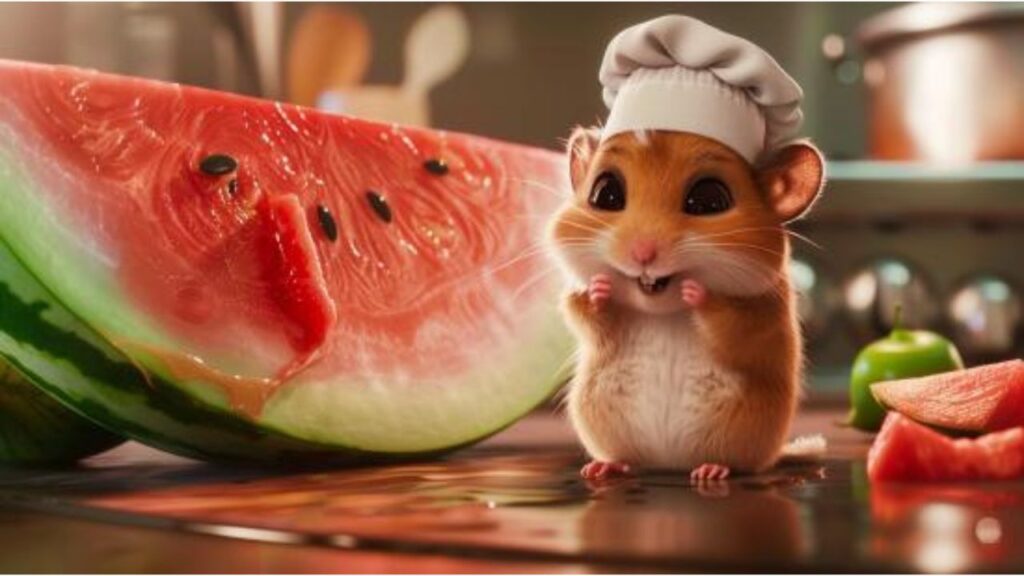
Peering into the world of hamster dietetics often leads to fascinating discoveries and, sometimes, to peculiar considerations—like whether the rind of a watermelon is a snack befitting our little furry companions. Given the array of human foods that can be toxic to hamsters, a thorough examination is paramount when introducing any new food item. In this case, we peel back the layers on watermelon rind consumption and its implications for hamster health.
The Digestive System of Hamsters
Hamsters have a digestive system that is quite efficient but also delicate. It is designed to handle a variety of foods, primarily seeds, grains, fruits, and vegetables. However, their gastrointestinal tract is not equipped to deal with large amounts of strange or new substances. Any new food item can potentially disrupt their digestive balance, leading to health issues.
The Importance of Gradual Dietary Changes
When considering introducing watermelon rind, or any new food, into a hamster’s diet, it should be done so gradually. Sudden changes can cause digestive upset, including diarrhea, which in hamsters can be particularly dangerous and lead to dehydration.
Is Watermelon Rind Safe for Hamsters?
While we’ve established that watermelon rind does contain some nutrients potentially beneficial for hamsters, determining its safety is about more than just its vitamin or fiber content. The rind’s tough texture is considerably different from the soft fruits and vegetables that hamsters are accustomed to, which could make it difficult for them to chew or digest.
Moderation and Preparation
Even if watermelon rind could be considered safe in terms of its substance, it must be given in moderation. Moreover, preparing it by removing any traces of the outermost green layer, which could contain pesticides or wax, is essential to make it safer for hamster consumption.
Potential Risks and Concerns
One significant risk of feeding watermelon rind to hamsters is its hard, fibrous texture, which could lead to dental issues or intestinal blockages. Their small size and sensitive digestive tracts mean that even a small piece of tough rind could cause problems.
The Threat of Chemical Residues
The possibility of chemical residues on the rind from pesticides and other agricultural chemicals poses another serious risk. These substances can be particularly toxic to small animals like hamsters.
Balancing Risk and Nutritional Reward
Considering the potential risks versus the nutritional benefits, it’s vital to proceed with caution. If an owner decides to offer watermelon rind, it should only be after thorough cleaning and in small, manageable amounts to watch for any adverse reactions.
In the careful consideration of whether hamsters can eat watermelon rind, the overarching theme is one of cautious evaluation. Given the potential risks, it might be prudent to stick to safer, well-established treats and foods for your hamster. If you choose to proceed, do so with the utmost care and under the guidance of a veterinarian.
How to Safely Introduce Watermelon Rind to a Hamster’s Diet

In the intricate dance of managing a hamster’s dietary needs, introducing new foods such as watermelon rind requires a choreographed approach. It’s akin to introducing a hamster to a new exercise wheel—proceed with caution, patience, and a watchful eye for any missteps. Let’s nibble our way through the process of preparing watermelon rind and establishing the appropriate serving size and frequency for these little critters.
Preparing Watermelon Rind for Hamsters
Begin with selecting an organically grown watermelon to minimize exposure to pesticides. Wash the outside of the watermelon thoroughly under running water, using a produce brush to gently scrub the surface. This step helps to remove any residues on the rind’s surface.
Peeling Off the Green
Once the watermelon is clean, peel away the hard, green outer layer of the rind. This part can be too tough for hamsters and may also contain the highest concentration of any harmful substances. You’ll want to provide them with the white part of the rind, which is softer and closer to the flesh.
Cut to Size
Chop the white rind into tiny, hamster-bite-sized pieces. Considering the size of a hamster’s mouth, the pieces should be small enough to be held in their little paws—think no larger than a sunflower seed in size.
Moderation is Key
As with any new food, start with a minuscule piece to allow your hamster’s digestive system to adjust. Even though watermelon rind is not part of their natural diet, if it’s prepared correctly, it can be tested in very small amounts.
Serving Size and Frequency
Introduce a tiny piece of the prepared watermelon rind as an occasional treat—not as a meal replacement or a significant part of their diet. Watch how your hamster reacts to the new food both behaviorally and digestively.
Monitoring the Aftermath
Keep an eye on your hamster’s stool after introducing the rind. Loose stools or changes in behavior may indicate that the rind is not agreeing with them, and if this is the case, it’s important to remove it from their diet and consult with a veterinarian.
Gradual Increases
If your hamster enjoys the rind and exhibits no adverse reactions, you can consider giving it as a treat perhaps once a week. However, it’s crucial to observe their reaction each time. Any negative signs, and the rind should be eliminated from their diet.
Always in Small Doses
Remember, the digestive system of a hamster is quite sensitive. Even if they seem to enjoy the rind and suffer no immediate ill effects, it should never become a regular part of their diet. Treats like watermelon rind should make up a very small fraction of their overall food intake.
Whisker Tips: Treating Your Hamster Right
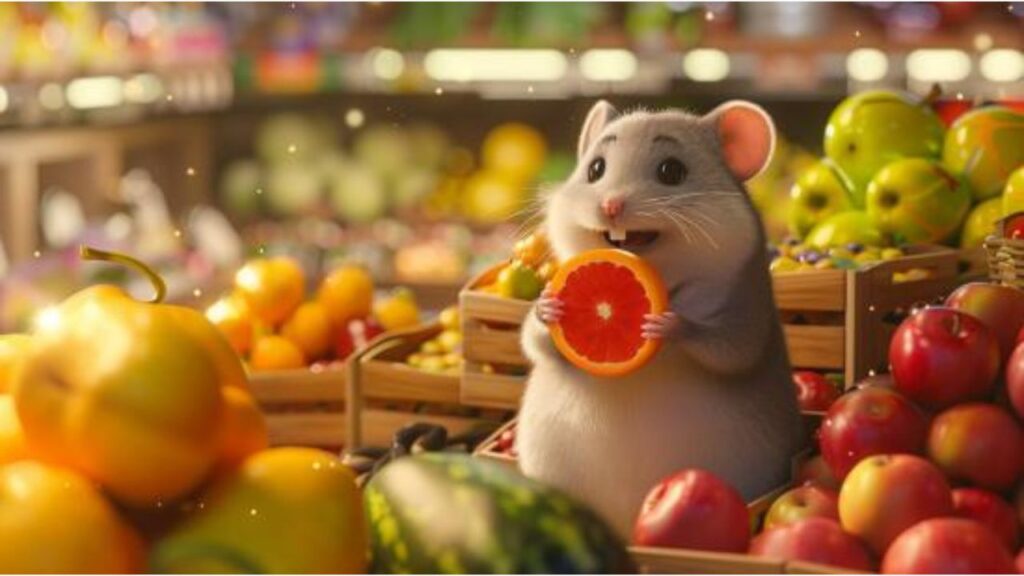
Embarking on the culinary exploration of your hamster’s diet can be an exciting venture. However, as with any daring journey, there are best practices to uphold for the safety and happiness of your whiskered companion. Here in ‘Whisker Tips’, we will delve into the art of introducing new treats to your hamster and consider some alternatives to watermelon rind.
Best Practices for Feeding Hamsters New Treats
Before introducing any new treat, make sure it’s hamster-approved. Research is key. A quick consultation with a vet or a credible resource on hamster care can save you from making a dietary misstep.
Introduce Gradually
When it’s time to introduce a new treat, start small. Offer a tiny piece and wait 24-48 hours to observe any adverse reactions. This patience allows you to monitor your hamster’s tolerance and enjoy the treat without any digestive distress.
Monitor Closely
Keep a close eye on your hamster’s behavior and stool after they’ve consumed the new treat. Any sign of diarrhea, lethargy, or changes in appetite should be a red flag, prompting the immediate removal of the new food and possibly a visit to the vet.
Maintain a Balanced Diet
Remember, treats are just that—treats. They should not replace the staple components of your hamster’s diet, such as a high-quality hamster mix, fresh water, and the occasional fruit or veggie nibble.
Clean Up
Hamsters are known to store food in their cheeks and bedding. Ensure any uneaten fresh treats are removed from the cage promptly to prevent spoilage and the growth of harmful bacteria.
Alternatives to Watermelon Rind
If you find the idea of preparing watermelon rind too daunting or if your furry friend doesn’t take to it well, there are many other hamster-safe treats you can offer.
Fresh Fruits and Veggies
Offer small amounts of hamster-safe fruits and veggies, such as cucumber, apple (seedless), or carrot. These provide hydration and nutrients and are generally easier on their digestive system.
Hay or Timothy Grass
These can be excellent for nibbling and help keep your hamster’s teeth in good shape, all while being easy to digest.
Commercially Prepared Hamster Treats
Opt for treats designed specifically for hamsters. These are formulated to be safe and nutritious, reducing the guesswork for pet owners.
Cooked Plain Eggs
A bit of cooked egg offers a protein boost and can be a welcome change from the usual fare. Ensure it’s cool and cooked without any oils or seasonings.
Whole Grains
Occasionally, you can offer cooked plain brown rice or whole grain pasta. Make sure these are cooled and serve in very small portions.
Feeding your hamster should always be a fun and safe experience for both of you. By following these Whisker Tips, you can ensure that treat time is always a delight, never a gamble. Remember, variety is the spice of life, but consistency is the key to health—particularly in a hamster’s diet.
Conclusion

To nibble or not to nibble, that has been the question. In our quest to understand whether hamsters can safely eat watermelon rind, we’ve sliced through the juicy details and arrived at some essential considerations. We learned that while watermelon rind does contain some nutrients potentially beneficial for hamsters, it is not a natural part of their diet and must be introduced with caution—if at all.
The key points to remember include understanding the delicate nature of a hamster’s digestive system and recognizing the need for a balanced and consistent diet. When contemplating new treats like watermelon rind, preparation is vital—ensuring it is free from pesticides and cut into manageable, bite-sized pieces. Moreover, moderation is paramount, as is careful monitoring for any signs of digestive upset.
Alternatives to watermelon rind that are safer and just as enriching for your hamster’s diet abound. Fresh vegetables, select fruits, and specially formulated hamster treats can provide both nutrition and variety without the risks associated with harder, fibrous foods.
The overarching theme of our findings reiterates the importance of cautious dietary introductions for hamsters. These small creatures depend on us to make wise choices about their diet, and with the right approach, we can keep their tiny bellies full and their whiskers twitching in contentment.
As we wrap up our exploration of hamster dietary dos and don’ts, let us part with this whisker of wisdom: when in doubt, choose the safer route. Your hamster’s health is too precious to risk on a slice of uncertainty. Keep their diet simple, safe, and satisfying, and you’ll have a furry friend who’s not only healthy but wheel-y happy. And that’s what it’s all about, isn’t it? Because remember, a happy hamster is a wheel-y happy you!

